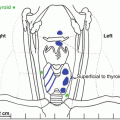© Mayo Foundation for Medical Education and Research 2016
Ann E. Kearns and Robert A. Wermers (eds.)Hyperparathyroidism10.1007/978-3-319-25880-5_1717. Medication Considerations in Hypercalcemia and Hyperparathyroidism
(1)
Division of Endocrinology, Diabetes, Metabolism, and Nutrition, Department of Internal Medicine, Mayo College of Medicine, Mayo Clinic, Rochester, MN, USA
(2)
Department of Internal Medicine, Sanford University of South Dakota Medical Center, Sioux Falls, SD, USA
Keywords
Primary hyperparathyroidismHypercalcemiaHydrochlorothiazideLithiumBisphosphonatesTeriparatideEstrogenRaloxifeneAromatase inhibitorsTenofovirCase Presentation
An 82-year-old female is referred for evaluation of hypercalcemia, with a serum calcium of 11.7 mg/dL (nl, 8.9–10.1) that was identified on lab work 1 month prior after she complained of increasing fatigue over the last 2 months. Subsequent laboratory testing identified the following: serum calcium – 10.8 mg/dL and phosphorus – 3.7 mg/dL (nl, 2.5–4.5) with at concomitant PTH of 48 pg/mL (nl, 15–50). Previous calcium measurements were noted to be normal, but more recently when checked, were high normal. Further laboratory studies that were done and normal included TSH, complete blood count, serum protein electrophoresis, serum creatinine, and 25-hydroxyvitamin D. Her medications of note included one calcium carbonate daily (600 mg elemental calcium per tablet), one multivitamin per day, and hydrochlorothiazide 25 mg one daily for hypertension. Her estimated daily dietary calcium intake was 600 mg per day. She denied a history of external beam radiation treatments to her head or neck, and there was no family history of primary hyperparathyroidism (PHPT) or hypercalcemia, familial endocrine syndromes, or hip fractures.
She denied a history of nephrolithiasis or fragility fractures. Her dual-energy X-ray absorptiometry (DXA) bone mineral density (BMD) revealed a non-dominant left one-third radius T-score of – 0.5, worst femur neck T-score of – 2.0, and lumbar spine T-score of – 1.0. The hip and spine had declined 6.2 % and 4.7 %, respectively, both greater than the least significant change, from the previous measure done approximately 6.5 years previously. Her physical examination revealed a height of 157.6 cm, weight of 85.1 kg, and blood pressure of 136/64 but was otherwise unremarkable.
Assessment and Diagnosis
The patient’s lab work is consistent with primary hyperparathyroidism (PHPT). However, thiazide diuretics can also be associated with hypercalcemia [1]. Increased renal tubular reabsorption of calcium resulting in reduced urine calcium excretion is the most likely explanation for hypercalcemia associated with thiazide diuretics [2–4]. A mean increase of 0.8 mg/dL in albumin-adjusted serum calcium level is seen with thiazide use. Serum calcium concentrations are increased independently of PTH [5]. However, the increase in renal tubular calcium resorption and serum calcium is no longer observed after 2 years of therapy [6]. Upon review of the patient’s medical record, she had been on hydrochlorothiazide for more than 10 years, making it unlikely that thiazide use was the primary cause of her hypercalcemia. It is estimated that approximately two-thirds of patients with thiazide-associated hypercalcemia have underlying PHPT, based on the persistence of hypercalcemia after discontinuation of the thiazide [1]. Additional factors favoring PHPT in thiazide-associated hypercalcemia include higher serum calcium and PTH levels at diagnosis [1].
Several other medications have effects on PTH and serum calcium that should be considered when evaluating patients with PHPT. In women with PHPT, estrogen and raloxifene lower serum total calcium, but PTH levels do not change significantly [7, 8]. PTH secretion can also be modified by calcium [9] and vitamin D supplements [10] in PHPT subjects. Lithium has been associated with hypercalcemia as well as parathyroid hyperplasia and adenomas [11].
There are a number of other commonly used medications that can influence PTH and calcium measurements in patients without PHPT. Aromatase inhibitors such as letrozole have been associated with a reduction in PTH in postmenopausal women likely related to efflux of calcium from the skeleton with lower estrogen levels [12]. On the other hand, there is a trend toward an increase in PTH with estrogen treatment in postmenopausal women without PHPT likely related to a reduction in skeletal calcium release [13, 14]. Similarly, antiresorptive osteoporosis therapies such as denosumab [15] and potent bisphosphonates [16–18] can also be associated with an increase in PTH and reductions in serum calcium levels. Teriparatide, rhPTH (1–34), can lead to mild elevations of serum calcium in osteoporotic subjects, but are generally not clinically meaningful [19]. In addition, the timing of the serum calcium measurement after the teriparatide is critical, such that measures done >16 h post-dose are unlikely to be elevated [19, 20]. Several antihypertensive agents have effects on PTH secretion without significant effects on serum calcium including loop diuretics and calcium channel blockers which have been associated with an increased PTH [21, 22], whereas renin-angiotensin-aldosterone system inhibitors have been associated with a lower PTH [22]. Finally, antiretroviral therapy for HIV-1 infection which includes tenofovir disoproxil fumarate (TDF) is also associated with increased PTH and excess bone loss [23].
Management
The patient followed-up 3 months after discontinuation of hydrochlorothiazide and her serum calcium and phosphorus were 11 mg/dL and 3.6 mg/dL, respectively, with a PTH of 70 pg/mL, consistent with PHPT. Long-term discontinuation of hydrochlorothiazide may not be necessary in patients with thiazide-associated hypercalcemia since serious sequelae related to hypercalcemia in these patients despite continued use are rare [1]. However, she remained off of hydrochlorothiazide and opted to observe after a discussion about the risks and benefits of parathyroid surgery. She did have a 10-year probability of major osteoporotic and hip fracture risk, as calculated by WHO Fracture Risk Assessment Tool (FRAX®), of 15 % and 4 %, respectively. Hence, after a discussion of risks and benefits of alendronate therapy, she decided to initiate treatment. She was advised to continue her current calcium intake and avoid falls.
Stay updated, free articles. Join our Telegram channel

Full access? Get Clinical Tree





